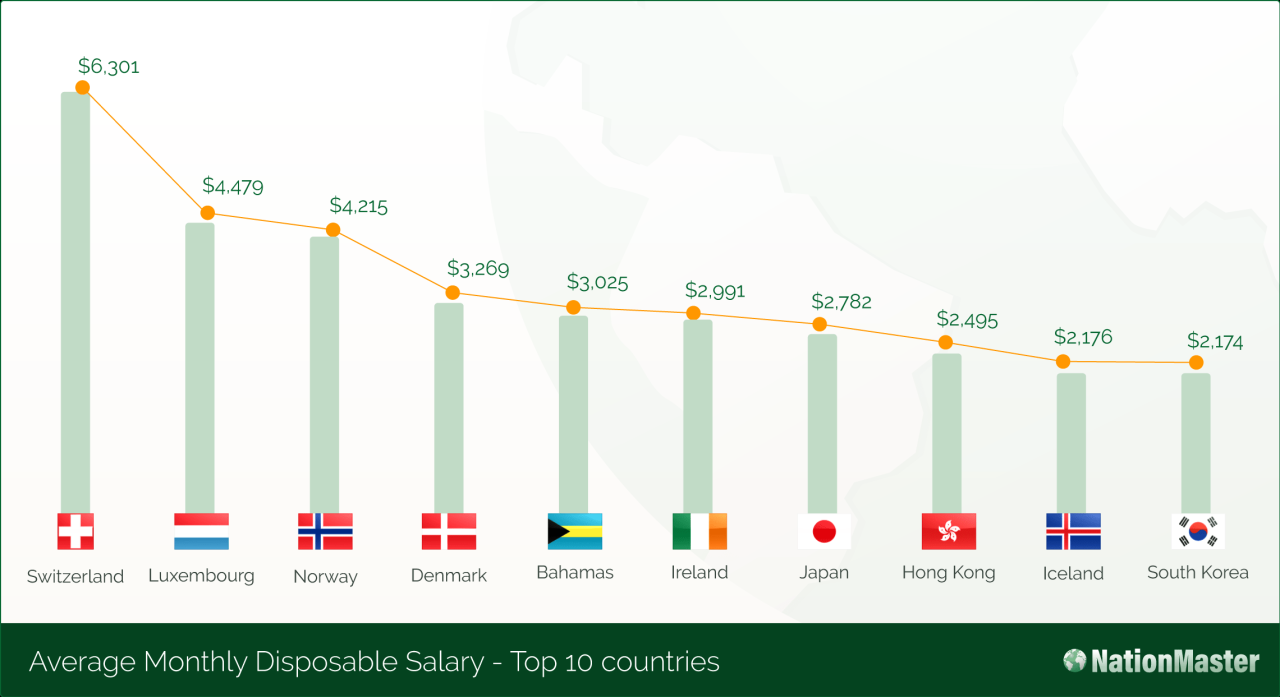Relocating to a new country is an exciting prospect, but careful consideration of the cost of living is crucial for a smooth transition. This guide breaks down the key factors influencing cost differences across nations, offering practical insights and actionable steps to assess living expenses in your chosen destination. Understanding these costs upfront helps you make informed decisions and prepare a realistic budget for your new life abroad.
From housing and food to transportation and healthcare, this guide explores the essential elements impacting your financial well-being in a new country. Detailed comparisons and practical examples are provided to help you effectively estimate and manage your budget. The information presented is designed to empower you with the knowledge to navigate the financial landscape of your new home.
Introduction to Cost of Living
The cost of living in a new country significantly impacts the financial well-being of a relocating individual or family. It encompasses all expenses required to maintain a standard of living, including housing, food, transportation, utilities, healthcare, and entertainment. Understanding these costs is crucial for realistic budgeting and planning during the relocation process.Cost of living disparities across countries are driven by a complex interplay of factors.
Economic conditions, such as inflation rates and employment levels, play a major role. Differences in the availability and pricing of goods and services, like housing, food, and transportation, are influenced by local supply and demand, as well as government regulations and policies. Cultural norms and lifestyle expectations also contribute to variations in cost of living.Accurately assessing the cost of living in a new country before relocating is essential.
This foresight allows individuals to adjust their financial expectations, develop a more comprehensive budget, and make informed decisions about their financial future. Failing to account for these differences can lead to unexpected financial strain and difficulty in maintaining a comfortable lifestyle.
Key Factors Influencing Cost of Living
A variety of factors contribute to the cost of living differences between countries. These factors are interconnected and influence each other in complex ways.
- Economic Conditions: Factors such as inflation rates, employment levels, and economic growth significantly impact the purchasing power of individuals and families in a given country. High inflation erodes the value of currency, increasing the cost of essential goods and services. Strong economic growth generally leads to higher wages and greater purchasing power.
- Local Supply and Demand: The availability and pricing of goods and services are influenced by the local supply and demand dynamics. Scarcity of resources, like affordable housing in a popular tourist destination, can drive up prices. Conversely, an abundant supply of goods can lead to lower prices.
- Government Regulations and Policies: Government policies, including taxes, subsidies, and regulations on various industries, can significantly affect the cost of living. For instance, government subsidies for healthcare or public transportation can lower the overall cost of living for residents.
- Cultural Norms and Lifestyle Expectations: Cultural factors also play a significant role in the cost of living. Different societies may have different standards for housing, food, and entertainment, leading to variations in spending patterns. The cost of certain activities, like dining out or attending cultural events, can vary considerably depending on local customs.
Comparison of Basic Necessities
This table illustrates the potential cost differences in basic necessities between two contrasting countries: Japan and Mexico. Note that these figures are illustrative and may vary based on specific locations and individual circumstances.
| Item | Japan (Example City: Tokyo) | Mexico (Example City: Mexico City) |
|---|---|---|
| Rent (1-bedroom apartment) | ¥150,000 – ¥250,000 (approximately $1,100 – $1,850) | MXN 8,000 – MXN 15,000 (approximately $400 – $750) |
| Groceries (weekly) | ¥15,000 – ¥30,000 (approximately $110 – $220) | MXN 1,000 – MXN 2,000 (approximately $50 – $100) |
| Transportation (monthly) | ¥10,000 – ¥20,000 (approximately $75 – $150) | MXN 500 – MXN 1,000 (approximately $25 – $50) |
| Utilities (monthly) | ¥5,000 – ¥10,000 (approximately $37 – $75) | MXN 500 – MXN 1,000 (approximately $25 – $50) |
Housing Costs

Understanding housing costs is crucial for anyone considering relocating to a new country. Factors like rental rates, mortgage availability, and utility expenses significantly impact the overall cost of living. This section delves into the diverse aspects of housing expenses, providing a comprehensive overview of the options and associated costs.
Types of Housing Options
Different housing options cater to various needs and budgets. These include apartments, houses, townhouses, and condos. Apartments, often found in urban areas, typically offer a lower initial investment but may have restrictions on renovations. Houses offer more space and flexibility, but come with higher initial costs and maintenance responsibilities. Townhouses balance the benefits of both houses and apartments.
Condominiums provide a middle ground in terms of space and cost compared to houses and apartments, but come with homeowner association fees. The best choice depends on individual preferences, lifestyle, and financial circumstances.
Rental Costs in Different Locations
Rental costs fluctuate considerably across different neighborhoods and cities within a country. Urban centers generally have higher rental costs due to increased demand and limited availability. Suburban areas typically offer more affordable options, but may require longer commutes. Comparing rental costs between different cities and neighborhoods allows for a clearer picture of the price range. For example, a two-bedroom apartment in the city center of a major European capital might cost significantly more than a similar property in a less populated suburb.
This variation is a critical factor to consider when evaluating housing affordability in a new location.
Mortgage Costs
Mortgage availability and costs vary across countries. Interest rates play a significant role in the overall mortgage expense. For example, in some countries, mortgage interest rates are relatively stable and predictable, while in others, rates may fluctuate more widely. Understanding the prevailing interest rates in a specific country is essential for accurate cost projections. For instance, in countries with a robust housing market, mortgage availability and lower interest rates are generally common.
Utilities and Maintenance Costs
Utilities and maintenance expenses are crucial components of total housing costs. Electricity, gas, water, and internet costs vary depending on the housing type, location, and usage. For example, a larger house will likely have higher utility bills than a smaller apartment. Maintenance costs also vary considerably, with factors like building age, condition, and upkeep impacting the overall expense.
Average Housing Costs by Size
| Home Size | Average Monthly Rent (USD) | Average Monthly Mortgage (USD) | Average Monthly Utilities (USD) | Average Monthly Maintenance (USD) |
|---|---|---|---|---|
| 1 Bedroom Apartment | 800-1200 | 900-1500 | 150-250 | 50-100 |
| 2 Bedroom Apartment | 1000-1500 | 1200-1800 | 200-300 | 50-120 |
| 3 Bedroom House | 1500-2500 | 1800-2800 | 250-400 | 100-150 |
Note: These figures are estimates and may vary significantly depending on the specific location and condition of the property.
Food Costs

Food costs are a significant component of the overall cost of living. Understanding the price variations in staple foods, restaurant dining options, and the impact of local produce availability is crucial for accurate budgeting. This section provides a comparative analysis of food costs in different countries, offering insights for individuals and families relocating.
Comparing Staple Food Prices
Comparing the prices of staple food items in different countries reveals significant variations. For instance, the price of a kilogram of rice can differ substantially between countries, reflecting regional production costs, import/export tariffs, and market demand. Similarly, the price of wheat flour, a fundamental ingredient in many cuisines, shows considerable discrepancies. These differences are influenced by factors like agricultural practices, availability of local ingredients, and the prevalence of food processing industries.
Analyzing these prices provides a clear understanding of the potential financial implications of adopting a new diet.
Restaurant Dining Costs
Restaurant dining experiences, particularly in a new country, offer a diverse range of price points. Budget-friendly options, such as local street food vendors or casual eateries, often provide substantial value. Mid-range restaurants, catering to a wider customer base, can vary in pricing depending on location and menu offerings. Fine dining establishments typically present the most expensive options, reflecting premium ingredients, extensive menus, and sophisticated service standards.
Understanding the range of restaurant prices in a new country allows individuals to choose dining experiences that align with their budget.
Impact of Local Produce Availability and Costs
Local produce availability and costs significantly influence the overall food budget. Regions with abundant local produce, featuring seasonal availability and affordable prices, tend to offer more cost-effective options. Conversely, areas reliant on imported produce or facing limited seasonal availability often see higher prices. This fluctuation in prices should be factored into the overall cost of living calculations.
Consider the potential need to supplement your diet with imported goods or adjust your grocery shopping strategy depending on the local conditions.
Grocery Shopping Costs for a Family of Four
Grocery shopping for a family of four in a new country requires a detailed understanding of the costs of essential food items. This often involves considering the price of staples like milk, eggs, bread, and meat. The cost of fresh produce, such as fruits and vegetables, will also need to be evaluated, and the availability of affordable alternatives should be assessed.
Understanding the specific needs of a family will aid in creating a realistic grocery budget. Local market conditions and seasonal variations must be taken into account.
Average Weekly Grocery Bills
| Country | Single Person (USD) | Family of Four (USD) |
|---|---|---|
| Country A | 50-75 | 200-300 |
| Country B | 65-90 | 250-400 |
| Country C | 40-60 | 150-250 |
Note: These figures are approximate averages and can vary depending on individual dietary preferences, shopping habits, and the specific products purchased.These figures, though approximate, provide a general comparison of weekly grocery costs for a single person and a family of four in different countries. Consider factors like purchasing in bulk, choosing affordable alternatives, and utilizing coupons or discounts.
Transportation Costs
Understanding transportation costs is crucial for accurately assessing the overall cost of living in a new country. Factors such as the availability and efficiency of public transport, vehicle ownership costs, and the prevalence of ride-sharing services significantly impact daily life and budget allocation. These expenses, when considered alongside housing, food, and other necessities, provide a comprehensive picture of the financial realities of living abroad.
Public Transportation Systems and Costs
Public transportation systems vary considerably across countries. Some nations boast extensive and affordable metro systems, buses, and trains, while others rely more heavily on individual vehicles. The cost of utilizing these systems, including fares, passes, and supplementary fees, can be a substantial part of a household budget. For example, a daily commute using public transport in a major European city might cost significantly more than in a smaller, less developed country.
This disparity in cost reflects differences in infrastructure, operating expenses, and the demand for public transport services.
Vehicle Ownership and Operating Costs
The cost of owning and operating a vehicle differs dramatically between countries. Factors influencing these costs include fuel prices, insurance premiums, vehicle taxes, maintenance costs, and the overall cost of the vehicle itself. For instance, purchasing a compact car in the United States might be more expensive than in a country with lower import duties or cheaper manufacturing costs.
Similarly, insurance costs can vary considerably depending on the country’s regulations and the perceived risk of accidents.
Ride-Sharing Services and Taxis
Ride-sharing services and taxis are becoming increasingly popular means of transportation in many countries. Their availability and affordability vary significantly, often influenced by factors like local regulations, competition among providers, and the overall economic conditions of the region. For example, ride-sharing services are widely available in major cities worldwide, offering convenient and relatively affordable transportation options compared to traditional taxis.
However, costs can fluctuate depending on demand, time of day, and distance. Similarly, taxi fares often vary by location and time of day, with surge pricing sometimes applied during peak hours.
Fuel Costs in Different Countries
Fuel costs play a significant role in transportation expenses. These costs are influenced by global market conditions, local taxes, and government policies. Fluctuations in crude oil prices can significantly impact the cost of gasoline, diesel, or other fuel types. For example, countries with limited domestic oil production are often more vulnerable to global price fluctuations. It’s essential to consider fuel costs when evaluating transportation expenses, especially for those who own or frequently use private vehicles.
Summary of Transportation Costs in [Country Example]
| Transportation Option | Approximate Cost (per unit/period) |
|---|---|
| Public Bus | $1.50 (per ride) |
| Metro | $3.00 (per ride/day pass) |
| Taxi | $5.00 (per mile/ride) |
| Ride-sharing service | $4.00 (per mile/ride) |
| Vehicle Ownership (per month) | $300-$500 (includes fuel, insurance, maintenance) |
Note: Costs are approximate and can vary based on specific circumstances and usage.
Healthcare Costs
Understanding healthcare costs in a new country is crucial for planning and budgeting. The healthcare system’s structure, insurance options, and pricing for medications and emergencies significantly impact an individual’s financial well-being. This section details the various aspects of healthcare costs, providing a comprehensive overview of the factors to consider.
Healthcare Systems in Different Countries
Different countries employ various healthcare systems, each with its unique characteristics and associated costs. Some nations have universal healthcare systems, providing comprehensive coverage to all citizens, while others rely on private insurance models. These systems significantly influence the costs of healthcare services, insurance premiums, and out-of-pocket expenses. The availability and quality of healthcare facilities, doctors, and medical specialists also vary between systems.
Insurance Costs for Expats and Locals
Insurance costs for expats and locals differ significantly depending on the healthcare system. In countries with universal healthcare, expats may face additional costs or have to enroll in a supplementary insurance plan to receive comprehensive care. Conversely, in countries with predominantly private insurance, expats may need to obtain international health insurance or a plan designed for expats. Insurance premiums for locals will vary based on their specific coverage plans, age, and health status.
Prescription Medication Costs
The cost of prescription medications can fluctuate widely depending on the country. Factors such as the availability of generic medications, government regulations, and market forces influence the price of prescription drugs. In some countries, the cost of medications is heavily subsidized, leading to lower prices for residents, while others may see significantly higher prices.
Cost of Emergency Medical Care
Emergency medical care costs are a critical factor to consider when evaluating healthcare expenses in a new country. These costs can vary based on the type of emergency, the level of care required, and the location of the healthcare facility. Emergency rooms and specialized facilities may have higher charges compared to routine consultations. Understanding the pricing structure for emergency services is essential for appropriate budgeting.
Public vs. Private Healthcare Systems
Public healthcare systems often offer more affordable, comprehensive coverage to all citizens. In contrast, private healthcare systems typically provide higher quality care and more specialized treatment options, but at a significantly higher cost. The choice between these systems significantly influences the overall cost of healthcare. Countries with a mix of public and private systems may offer a combination of both affordability and access to specialized care.
Breakdown of Costs in a Sample Country (Example: Germany)
- Public Healthcare: Germany has a universal healthcare system. While it provides essential coverage, supplementary insurance for expats might be required for certain services, and it’s likely to be more affordable than private options. The cost of basic care is generally lower than in private systems, but specialized care or treatments might incur additional costs.
- Private Healthcare: Private healthcare in Germany offers faster access to specialists and often higher quality care but carries a much higher cost than the public system. This is often the choice for those with specific needs or a desire for a quicker response time.
- Prescription Medications: Germany has a system where generic drugs are widely available, keeping costs comparatively lower than in countries with a stronger reliance on brand-name medications.
- Emergency Care: Emergency care in Germany is generally accessible through public healthcare providers, and costs are typically manageable within the insured system, but expenses may still arise for out-of-network care.
Entertainment and Leisure

Exploring the cost of entertainment and leisure activities is crucial for understanding the overall cost of living in a new country. This aspect encompasses a wide range of expenses, from dining out and attending cultural events to enjoying recreational activities like visiting museums or parks. Understanding these costs helps individuals budget effectively and make informed decisions about their lifestyle in a new environment.
Entertainment Options and Costs
The availability and cost of entertainment options vary significantly across different cities and countries. Factors such as cultural preferences, local events, and economic conditions all play a role in shaping the entertainment landscape. From live music venues to movie theaters, the diversity of entertainment options reflects the unique character of each location. This wide range of choices allows individuals to tailor their leisure activities to their interests and budget.
Cost of Leisure Activities
Museums, parks, and sporting events are common leisure activities. Museum admission fees, park entry costs, and ticket prices for sporting events fluctuate depending on the country and city. For instance, some museums offer discounted rates for students or families, while others charge a flat fee for general admission. Park entry fees, if any, can be negligible in some locations, whereas large metropolitan parks might have entrance charges.
Similarly, ticket prices for sporting events differ significantly, often depending on the popularity of the team or event. The cost of these activities can be a substantial part of an individual’s leisure budget.
Cost of Dining Out and Cultural Events
Dining out in different countries can vary considerably. Restaurant costs depend on the type of cuisine, location, and ambiance. Casual dining options are generally more affordable than fine-dining establishments. The cost of attending cultural events, such as plays, concerts, and festivals, varies depending on the venue, artist, and the popularity of the event. Often, these costs are reflected in ticket prices.
Comparing prices across different cities and countries can provide a clearer picture of the typical cost of dining out and attending cultural events.
Comparison of Entertainment Costs Across Cities
The cost of entertainment in different cities within a country can vary significantly. For example, the cost of a movie ticket in a major city might be higher than in a smaller town. Similarly, the cost of attending a concert or a sporting event might differ depending on the location. Factors such as demand, local economies, and competition influence these prices.
This variation underscores the importance of researching the specific costs of entertainment in the cities an individual intends to visit or reside in.
Table of Entertainment Costs in Different Countries
This table provides a general overview of the approximate costs of various entertainment options in different countries. Note that these are estimates and actual costs may vary based on specific venues, events, and demand.
| Country | Movie Ticket (USD) | Museum Admission (USD) | Concert Ticket (USD) | Dining Out (USD, average meal) |
|---|---|---|---|---|
| United States | 12-18 | 15-30 | 50-200+ | 20-40 |
| Canada | 10-15 | 10-25 | 40-150+ | 18-35 |
| United Kingdom | 10-15 | 10-25 | 40-150+ | 20-40 |
| Japan | 15-20 | 10-25 | 50-200+ | 25-45 |
| France | 15-20 | 15-30 | 50-200+ | 25-45 |
Other Expenses

Accurately assessing the cost of living in a new country necessitates considering a range of additional expenses beyond basic necessities. These often-overlooked factors can significantly impact the overall financial picture. Understanding the nuances of clothing, personal care, education, and communication costs is crucial for a comprehensive budget.
Clothing and Fashion Costs
Fashion trends and clothing costs can vary substantially across countries. Factors like local manufacturing, import tariffs, and consumer preferences influence prices. A country with a strong domestic textile industry might offer more affordable options compared to a nation heavily reliant on imported clothing. For instance, clothing in some Asian countries might be significantly less expensive than in Western Europe due to lower production costs.
Personal Care Products and Services
Personal care products and services are another significant expense that varies widely based on local market conditions. Prices for toiletries, cosmetics, and hair care items are influenced by factors such as local production capabilities, import duties, and consumer preferences. The cost of salon services, haircuts, and other personal care treatments can also differ greatly between countries.
Education Costs for Children
Education costs for children are a major concern for families relocating internationally. These expenses can include tuition fees, school supplies, extracurricular activities, and potentially, transportation. For example, private international schools in certain countries can have significantly higher tuition fees compared to public schools. Understanding the education system and the various options available in the target country is vital.
This includes researching public and private school systems, and the costs associated with each. A specific country example would be the United States, where public school tuition is often significantly lower than private school tuition, with variations by state and local district.
Communication Services
Communication services, including phone and internet access, are essential components of daily life and vary widely by location. The cost of mobile phone plans, internet packages, and landline services is affected by factors like network infrastructure, government regulations, and competition. In countries with advanced digital infrastructure, internet and phone services are often more expensive compared to regions with less developed networks.
For instance, internet access in some developing countries might be more costly per unit of service compared to more established markets.
Comparison Table: Personal Care Item Costs
| Personal Care Item | Country A (Example: United States) | Country B (Example: Japan) | Country C (Example: India) |
|---|---|---|---|
| Shampoo (1-liter bottle) | $10-15 | $15-25 | $2-5 |
| Toothpaste (100g tube) | $3-5 | $5-8 | $1-2 |
| Hairdryer | $25-50 | $40-70 | $10-20 |
| Haircut (men’s) | $25-40 | $30-60 | $5-10 |
Note
* Prices are estimates and can vary based on specific brands, stores, and services.
Methods for Estimating Costs

Determining the cost of living in a new country requires a multifaceted approach. Simply relying on averages can be misleading. Understanding the nuances of daily expenses, from groceries to entertainment, is crucial for a realistic assessment. Thorough research and a practical approach are essential for accurate cost projections.Effective estimation methods allow individuals to gain a clearer picture of their financial needs and prepare for the realities of their new environment.
This involves gathering information from various sources and applying strategies for organizing and analyzing the data collected.
Utilizing Online Resources and Calculators
Online resources offer valuable tools for estimating costs in a new country. Cost of living calculators are readily available and provide a starting point for estimations. These tools frequently use data from surveys and reports to present a general picture of costs in various localities. However, individual circumstances and spending habits will inevitably impact the accuracy of the estimations.
Carefully consider the factors that may affect your own expenses, such as your lifestyle choices, desired standard of living, and family size. For example, a young professional living alone will likely have different cost estimations than a family with children.
Leveraging Local Communities and Expats
Gathering firsthand information from local communities and expatriates is crucial. Local residents provide insights into everyday expenses, such as the cost of groceries, transportation, and entertainment. Expatriates, who have firsthand experience living in the country, can offer invaluable perspectives on various aspects of cost of living, including the practicalities of day-to-day life and potential hidden costs. They can also discuss the actual experience of navigating the local economy, offering a more nuanced and realistic perspective.
Comparing and Contrasting Estimation Methods
Different methods for estimating cost of living offer various levels of detail and accuracy. Online calculators provide quick assessments, while surveys offer a broader overview of the cost of living. Gathering information from local communities offers a more nuanced view. Comparing these methods allows for a more comprehensive and accurate estimation. For example, a combination of online tools, surveys, and personal interviews provides a more complete picture of potential expenses.
Each method should be considered and weighed based on the individual’s needs and the level of detail required.
Spreadsheet Management of Cost of Living Data
Organizing and tracking cost of living data in a spreadsheet is an effective way to manage and analyze collected information. A spreadsheet can help keep track of various expenses, such as housing, groceries, transportation, and entertainment. This organized approach enables you to easily compare costs across different locations and over time.Using a spreadsheet, you can input the estimated costs from various sources, noting the specific source for each data point.
This allows for a comprehensive record and a comparison of the data. For instance, you could track the cost of a particular grocery item from different stores, providing a more accurate picture of its actual price. A spreadsheet allows for more comprehensive data management, allowing you to compare different methods of cost estimation, leading to a more realistic estimate of the cost of living in the new country.
Closure
In conclusion, determining the cost of living in a new country is a multifaceted process requiring thorough research and careful consideration. By evaluating housing, food, transportation, healthcare, entertainment, and other expenses, you can create a realistic budget and make informed decisions. This guide provides a structured approach to understanding the financial implications of relocation, enabling a smoother and more financially secure transition to your new life abroad.